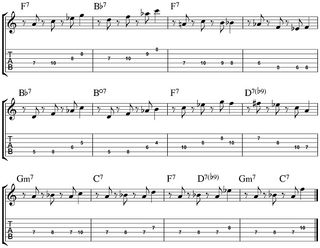Rhythmic Soloing Exercise for the Improvising Guitarist

With so many scales, arpeggios, licks, chords and patterns to learn in the practice room, sometimes we can overlook rhythm when working on our jazz guitar soloing concepts. Keeping a focus on rhythms and rhythmic motives in your solos can help take your playing to the next level, without having to learn any new concepts, just new approaches to the concepts you already have under your fingers.
In this lesson, you’ll learn a fun and essential jazz guitar rhythm exercise you can apply to your practice routine and take your playing to the next level of interest and creativity today.
Rhythmic Soloing Exercise
Here is the exercise in a nutshell so you can get the idea into your head before taking it to the fretboard.
1.Pick a short, one-bar rhythm to focus on in your solo
2.Pick a chord progression or tune to solo over with a backing track
3.Solo over the tune, using any notes you want, but every bar has the same rhythm
4.Practice these exercises at various tempos and with tunes of various lengths such as 8, 12, 16, 24 and 32 bars each
Now that you know how to build the exercise, here's a sample motive that you can begin using, as well as a sample solo using that motive to give you an idea of how the exercise could sound in the woodshed.
Sample Rhythmic Motive
Here's a sample rhythm I might use in my practicing that you can start with when first exploring these concepts in the practice room. The rhythm relies on three up beats, 1&, 2&, 3&, as well as a downbeat, 4, to build the one-bar long phrase. As an example, here is this rhythmic motive applied to a ii V I VI chord progression in the key of C major.

Once you have learned the sample lick above, try soloing over the same chord progression but make up your own notes to use with that static rhythm in order to take this motive further in the practice room.
Rhythmic Motive Blues Solo
To finish off our rhythmic motive study, here is a sample solo over an F blues progression that uses the same rhythm from the previous section.

When you have this short solo under your fingers, try improvising over an F blues using the same rhythm, but changing the notes as you work this idea into your own improvisational studies.
As you can see, focusing on rhythms when soloing can bring a new dimension to your soloing ideas. While you won’t play a single rhythm for an entire chorus in a real-life situation, focusing on one rhythm in the woodshed will allow you to keep rhythms in the forefront of your lines and improvised solos.
Do you have a questions or comments about this lesson? Share your thoughts in the COMMENTS section below.
Matt Warnock is the owner of mattwarnockguitar.com, a free website that provides hundreds of lessons and resources designed to help guitarists of all experience levels meet their practice and performance goals. Matt lives in the UK, where he is a lecturer in Popular Music Performance at the University of Chester and an examiner for the London College of Music (Registry of Guitar Tutors).
Get The Pick Newsletter
All the latest guitar news, interviews, lessons, reviews, deals and more, direct to your inbox!
Matt Warnock is the owner of mattwarnockguitar.com, a free website that provides hundreds of lessons and resources designed to help guitarists of all experience levels meet their practice and performance goals. Matt lives in the UK, where he teaches Skype guitar students all over the world, and is an examiner for the London College of Music (Registry of Guitar Tutors).



![Joe Bonamassa [left] wears a deep blue suit and polka-dotted shirt and plays his green refin Strat; the late Irish blues legend Rory Gallagher [right] screams and inflicts some punishment on his heavily worn number one Stratocaster.](https://cdn.mos.cms.futurecdn.net/cw28h7UBcTVfTLs7p7eiLe-840-80.jpg)







